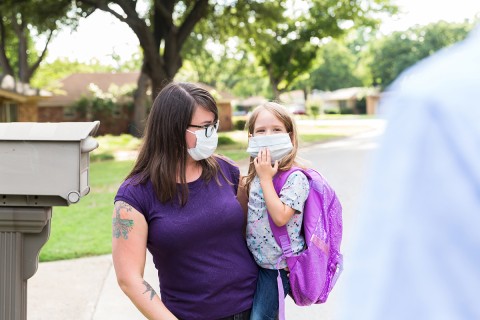Loving your neighbor starts with the people on your block
My five-year-old parishioner spent the summer going door to door.

When a lawyer asked Jesus one day, “Who is my neighbor?” the question presupposed that some people are not neighbors; that there are those we don’t have to care about. Spiritually, we know otherwise. No one is officially beyond the bounds of our concern. But loving all people requires we start somewhere. “The best preparation for loving the world at large,” John Henry Newman once preached, “is to cultivate an intimate friendship and affection toward those who are immediately about us.”
Meet Lucy Carlson, a five-year-old in my congregation, who is starting with her neighborhood. In her household, honest conversation about current events is a regular occurrence. When national anger followed the death of George Floyd, Lucy was coloring on her front porch one morning. She said to her mom, “I think it’s important to know our neighbors. I’m going to meet them all. If they need help, I want them to know where I live so they can come to me for help. I’m going to have them sign my paper so I know their name. But not in cursive.”
The next day, carrying an enormous piece of paper and a pouch of Crayola markers, Lucy and her mom headed to the first house. The family was cleaning out the garage when Lucy stepped up confidently. “Hi. I’m Lucy, and this is my mom, Erin. We live across the street, and I think it’s important to know your neighbors. So, I want you to sign my paper. You can come to my house if you need help, and I’ll help you.”
Smiling, each family member wrote their name with a marker. Nobody at the second house answered the door, so Lucy wrote down the address to remember to follow up later. At the third house, the moms got to talking. With some impatience, Lucy pulled her “phone” out of her pocket and started “typing.” Before long she said, “Mom, don’t you think it’s time to get going to the next house?” The neighbor asked what she was typing on. “It’s my phone. But it’s not a real phone. It’s actually a fan remote that doesn’t work.” The women laughed, and off went Lucy and her mother to the next house.
Lucy spent more summer days going house to house. She’d bring her poster-sized paper and pouch of markers along with her customary spiel. After introducing herself and telling the homeowner where she lived, she’d say, “I think it’s important to know your neighbors, so I want you to sign this.” As she handed them the paper adorned with rainbows and smiley faces, she made sure to point out her two glitter markers, but would also say, “You can pick whatever color you want.”
Erin spoke to me of being slightly embarrassed during these walks. “We’ve lived in our house for seven years, and I didn’t know the majority of people nearby. How many neighbors do you know?” she asked. “How well do you know even your closest neighbors beyond that obligatory wave?”
From her neighborhood journeys, Lucy learned how to make jam. Multiple neighbors offered their teenagers for babysitting. A retired music teacher let her strum the strings of his harp. Lucy showed off her yoga poses. She met a woman from China.
And then, Jacob Blake was shot. Lucy’s response: “Mom, I think we need to go meet some more neighbors.”
A version of this article appears in the print edition under the title “Know your neighbor.”






